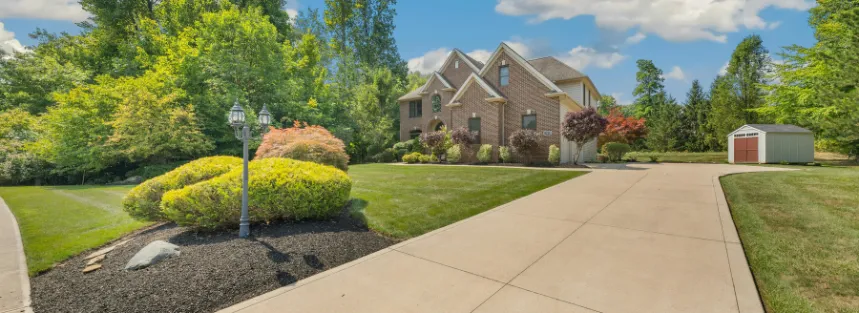Blog Detail
DIY Methods to Remove Weeds from Interlocking Brick Driveways
Table of Contents
ToggleWeeds growing between the joints of interlocking brick driveways are not just unsightly—they can damage the structure over time. As they push through the gaps, they cause shifting, loosening, and even long-term wear of the pavers. The good news is: you don’t need professional help every time weeds appear. There are simple, effective DIY methods to remove weeds from interlocking brick driveways using items you may already have at home.
In this blog, we’ll walk you through the most effective do-it-yourself weed removal techniques and offer tips to prevent them from coming back.
Why Do Weeds Grow in Interlocking Driveways?
Even though interlocking driveways are made to be durable and low maintenance, the spaces between the bricks can collect dirt, debris, and moisture—creating the perfect environment for weed seeds to settle and sprout. Over time, wind and birds carry seeds into these gaps, and with sunlight and moisture, weeds begin to grow.
That’s why regular upkeep and prevention are key to keeping your driveway weed-free.
1. Manual Weed Removal
Best For: Small driveways or light weed growth
Sometimes the most basic approach is also the most effective. Use a weeding tool, screwdriver, or even a butter knife to dig out weeds from between the pavers. Make sure to pull from the root to prevent regrowth.
Steps:
- Loosen the soil around the weed with your tool.
- Gently pull out the entire root system.
- Sweep away loosened debris and soil.
Pro Tip: Do this after rainfall when the soil is soft—it makes root removal easier.
2. Boiling Water Treatment
Best For: Quick spot treatment of young weeds
Boiling water is one of the easiest and most chemical-free weed killers available. The high temperature kills weeds by destroying their cell structure on contact.
Steps:
- Boil water in a kettle.
- Carefully pour the hot water directly onto the weeds.
- Repeat if necessary after a few days for stubborn weeds.
Caution: Avoid pouring boiling water near plants you want to keep. It can kill grass and flowers too.
3. Vinegar and Salt Solution
Best For: Natural weed control with long-lasting effects
Vinegar contains acetic acid, which draws moisture from the weed’s leaves and roots. Adding salt boosts effectiveness by dehydrating the roots, while dish soap helps the mixture stick to the weed surface.
DIY Mixture:
- 1 liter of white vinegar (5% acetic acid)
- 2 tablespoons of salt
- A few drops of dish soap
Steps:
- Mix all ingredients in a spray bottle.
- Spray directly on weeds during sunny weather.
- Avoid spraying on healthy plants or lawn areas.
Note: This method can alter soil quality, so use sparingly in areas where you plan to plant later.
4. Use a Weed Torch (Flame Weeder)
Best For: Driveways with heavy weed infestations
A weed torch uses direct flame to burn weeds down to the root. It’s a fast and efficient method—especially for large driveways.
Steps:
- Connect the torch to a propane tank.
- Pass the flame over the weeds briefly—don’t incinerate, just wilt them.
- Wait a day or two, then sweep or pull out dead weeds.
Safety Tips:
- Use only on non-flammable surfaces like pavers.
- Keep a water source nearby.
- Avoid use in windy or dry conditions.
5. Pressure Washing
Best For: Driveways with loose debris, moss, and surface-level weed growth
A pressure washer can dislodge weed roots, remove dirt, and wash away seeds hiding in cracks.
Steps:
- Set the washer to medium-high pressure.
- Direct the spray at the weed base and in between paver joints.
- Allow the area to dry and refill joints with polymeric sand (more on this below).
Bonus Tip: Use a surface cleaner attachment for even and safer cleaning.
Preventing Weeds from Returning
Removing weeds is only half the job—the key is to prevent regrowth. Here are some simple ways to reduce future weed issues:
1. Refill Joints with Polymeric Sand
After cleaning or pulling weeds, sweep polymeric sand into the joints between pavers. When activated with water, it hardens and prevents weed seeds from settling in.
2. Apply a Natural Pre-Emergent
Use corn gluten meal or other natural pre-emergent herbicides to prevent new seeds from germinating.
3. Keep the Driveway Clean
Regularly sweep your driveway to remove leaves, soil, and organic matter that collect in joints. A clean surface means fewer places for weeds to take root.
4. Seal Your Interlocking Pavers
Sealing your driveway helps prevent water and dirt from seeping into the joints. It also makes your pavers easier to clean and improves appearance. Most sealers last 2–3 years and are worth the investment.
Final Thoughts
Weeds between interlocking bricks are annoying, but they don’t have to be permanent. With the right DIY methods—like manual pulling, vinegar spray, boiling water, or pressure washing—you can safely and effectively clean your driveway. And by taking a few preventive steps like sealing and sanding, you can keep it weed-free long-term.
Keeping your interlocking driveway clean not only improves its appearance but also extends its lifespan and maintains property value.
Ready to give your driveway a full refresh? Consider pairing your weed-removal work with power washing and re-sanding for a like-new finish.
Ready to refresh your driveway?
Contact Legacy Builders today for a free estimate.

Written By
John Doe
Lorem ipsum dolor sit amet, consectetur adipiscing elit. Ut elit tellus, luctus nec ullamcorper mattis, pulvinar dapibus leo.
Office
Contact
info@interlocking.ca
(123) 456-789
Opening Hours:
Mon – Sun: 8:00-20:00



